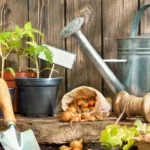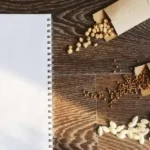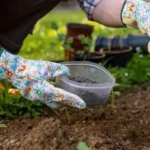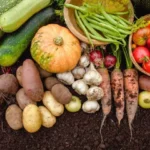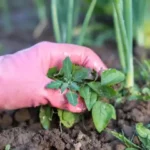Are you a backyard gardener who thinks that winter means the end of fresh produce? Think again! Cultivating vegetables that grow in winter can be a surprisingly rewarding and productive experience that provides the same nutritious produce as any other annual season. In this article, we’ll explore the top winter vegetables to grow and discuss essential tips for successful winter gardening.
Grow leafy greens, root veggies, alliums, cruciferous veggies, winter squash, cabbage, and radishes in winter. Use a hand cultivator, stakes or trellises, mulch, and organic fertilizers. Maintain soil pH levels between 6.0-7.0 and protect your crops from frost with a cold frame or hoop house. Grow lights or reflectors are used as an excellent sunlight substitute. Like any other season, observe any damage or infestations such as chewed leaves, discolored spots, or wilted stems.
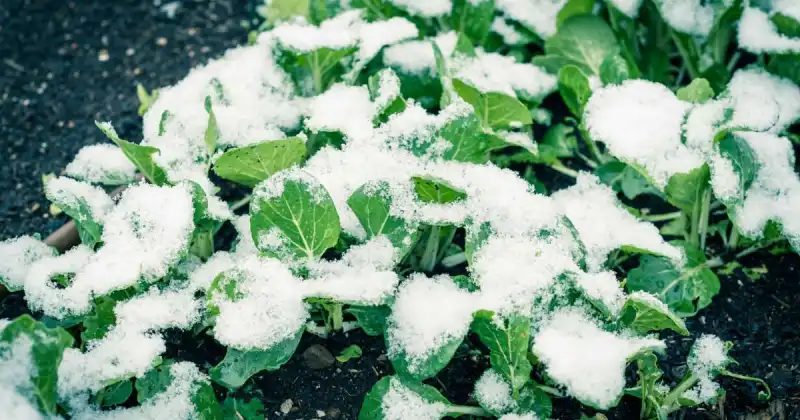
Fortunately, just because it gets cold outside doesn’t mean your gardening endeavors must cease. In this article, you’ll discover the techniques, tips, and tools needed to grow a diverse range of vegetables, even if you’re a complete beginner! Then, I will show you how to create a successful winter vegetable garden, from choosing the right location to harvesting and storing your crops.
Discover the benefits of winter vegetable gardening and how it can provide fresh, healthy produce even during the coldest months of the year. So let’s help you get on the right track to grow some amazingly delicious winter veggies!
Humble Highlights
- Save money by knowing precisely what frost-tolerant vegetables to grow and what tools you’ll need to get your winter garden up and running easily and efficiently.
- Discover these 5 common winter gardening tips AND determine which vegetables to plant during the 3 distinct winter micro-seasons so you can grow tasty and nutritious vegetables year-round.
- Save time by knowing how to harvest, clean, and store your winter veggies so you can keep your homegrown grub fresher for longer.
Top Winter Vegetables To Grow: Tools And Harvesting Tips
Several vegetables can be grown successfully during winter, including:
- Leafy Greens – kale, spinach, Swiss chard
- Root Vegetables – carrots, beets, turnips
- Cruciferous Vegetables – broccoli, cauliflower, Brussels sprouts
- Alliums – garlic, onions
- Other Vegetables – winter squash, cabbage, radishes
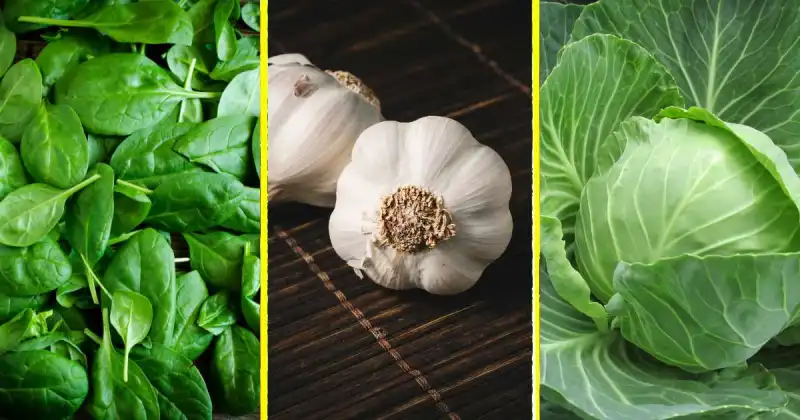
Let’s look at these unique winter vegetable varieties, what tools you’ll need, and the steps to follow to cultivate them.
Leafy Greens (Kale, Spinach, Swiss Chard)
These vegetables prefer cooler temperatures between 40-65°F (4-18°C). Fortunately, these leafy greens can tolerate frost and taste even sweeter after exposure to colder temperatures.
Below are the tools you need:
- Hand cultivator: helps loosen soil for better root growth
- Scissors or garden shears: for easy and precise harvesting of leaves to prevent tearing
- Liquid fertilizer: for additional nutrition and leafy growth during winter
The outer leaves of your foliage can be harvested when mature for leafy varieties like kale and spinach, leaving the smaller center leaves to continue growing. Moreover, these leaves can continue to be harvested throughout the winter until the plants start to bolt in the spring, as temperatures warm. 1
Root Vegetables (Carrots, Beets, Turnips)
Root vegetables grow best in soil temperatures between 40-60°F (4-15.5°C). However, like the leafy greens above, these vegetable varieties can tolerate colder temperatures, improving their flavor and sweetness after exposure to frost.
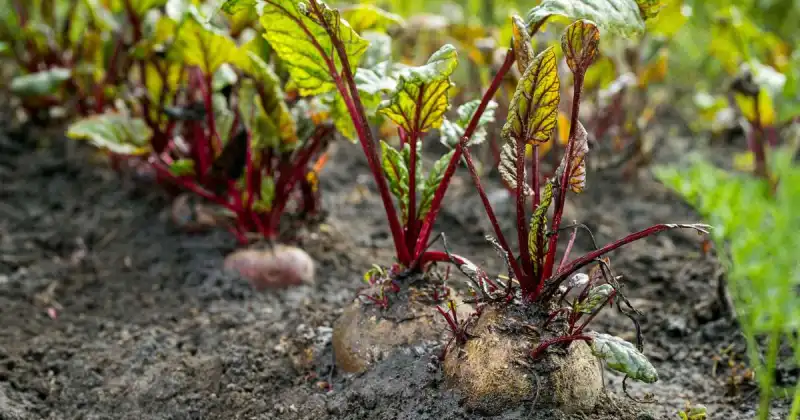
Below are the tools you need:
- Garden fork: for easy harvesting of root vegetables
- Soil thermometer: for monitoring soil temperature, which affects optimal root growth
- Organic fertilizer: for promoting root growth and development during winter
The harvest timing for root vegetables such as carrots and beets depends on the variety and the desired size. Generally, root vegetables can be harvested when they have reached their mature size, but they can be left in the ground until needed. However, harvesting them before the ground freezes is vital to prevent them from becoming damaged.
Cruciferous Vegetables (Broccoli, Cauliflower, Brussels Sprouts)
These vegetables prefer cool temperatures between 60-65°F (15-18°C) during the day and 50-60°F (10-15°C) at night. They can tolerate light frost but should be well-protected from hard freezes, or damage may be severe. 2
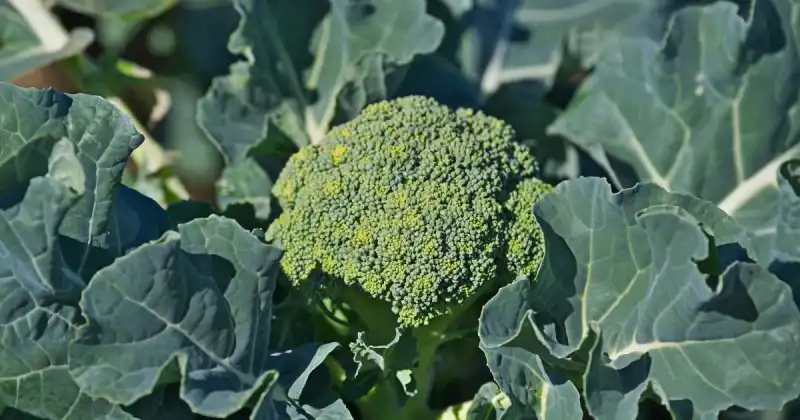
Below are the tools you need:
- Garden scissors: for precise and clean cutting of heads
- Garden stakes or trellis: for supporting taller plants and preventing them from falling over
- Compost: for providing essential nutrients and improving soil structure
For cruciferous vegetables such as broccoli and Brussels sprouts, the harvest timing depends on the variety and the size of the heads. The heads can be harvested when they have reached maturity, but they can also be left on the plant a bit longer, allowing them to develop fully.
Alliums (Garlic, Onions)
Alliums prefer cooler temperatures between 32-50°F (0-10°C) for complete bulb development. They can withstand colder temperatures but should be protected from prolonged exposure to freezing temperatures.
Below are the tools you need:
- Bulb planter: for easy planting of bulbs in the soil
- Mulch: for retaining moisture and preventing weed growth
- Liquid fertilizer: for promoting bulb growth and development
For alliums such as garlic and onions, the harvest timing depends on the variety and the desired size. Generally, alliums can be harvested when the leaves turn brown and dry out. However, it is important to harvest them before the weather becomes too wet, either through winter rain or melting snow, which can subsequently cause rot.
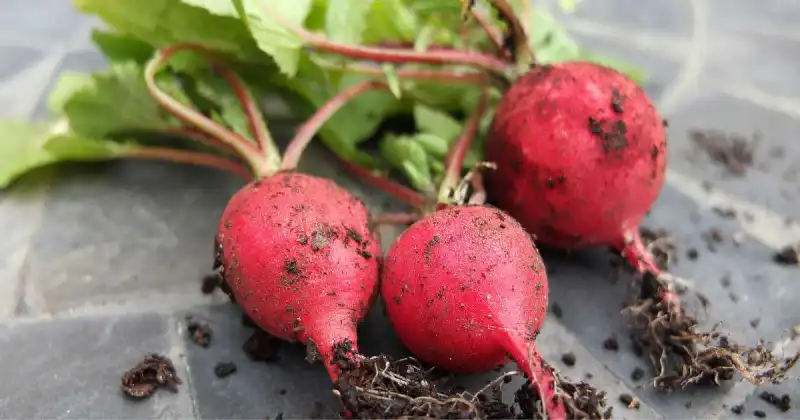
Other Vegetables (Winter Squash, Cabbage, Radishes)
These vegetables prefer cooler temperatures between 50-65°F (10-18°C) during the day and 40-55°F (4-13°C) at night. Although these veggies can tolerate light frost, they should be protected from hard freezes. 3
Below are the tools you need:
- Garden knife: for harvesting and cleaning vegetables
- Plant ties: for supporting heavy squash fruits
- Organic mulch: for retaining moisture and suppressing weed growth
The best time to harvest winter squash is when the fruit is fully mature, and the skin is hard, usually around 80-120 days after planting. A simple test you can perform to determine the maturity of the squash is to press your fingernail into the fleshy skin. It is likely mature and ready for harvest if your nail doesn’t leave an indentation. Another way to monitor fruit maturity is to look for a dried-out stem or tendril near the base of the fruit. If you see one, your squash is ready for picking.
Harvest timing of cabbage depends on the variety and the desired size, but generally, cabbage heads can be picked when they have reached their mature size and feel firm to the touch.
In winter, radishes are typically ready for harvest 3-4 weeks after planting, when the roots are around 1 inch in diameter. Harvesting them before they become too large or start to crack is best, so keep an eye on the top of the bulbs as they begin to poke through the top layer of soil.
Tips For Growing Winter Vegetables
To successfully grow winter vegetables, you’ll need to follow some basic foundational steps, including:
- Choosing The Right Location
- Preparing The Soil
- Determine Whether You’ll Be Sowing Seeds Or Starts
- Providing Enough Light
- Mulching To Retain Moisture
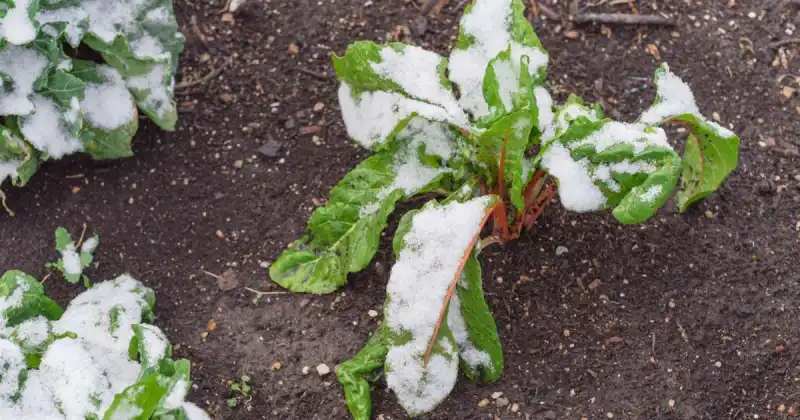
Choosing The Right Location
Look for the right location in your garden which gets full sun (at least 6 hours), has good drainage, and is protected from harsh winter winds. A south-facing slope or wall can also help to maximize sunlight and provide additional warmth your plants will enjoy. Additionally, it’s crucial to choose a location that is convenient and easily accessible for frequent maintenance and harvesting, as you likely won’t want to spend prolonged periods outside in the cold, as you would in the warmer parts of the year.
Additionally, consider setting up a cold frame or a hoop house to protect your plants from frost and cold temperatures, primarily if your region typically deals with frigid weather.
Preparing The Soil
Remember how important the soil is for your garden? It’s the engine that runs your entire growing operation because you first need to have healthy soil to cultivate productive plants. Well, in winter, your garden soil is even more critical. 4
The ideal soil for winter vegetables should be rich in organic matter and retain a pH between 6.0 and 7.0. To achieve this, gardeners can incorporate compost, aged manure, or other organic matter into the soil to improve its fertility and structure. This practice will also help to increase the soil’s water-holding capacity and promote better root development. The ground must be well-draining, as waterlogged soil can lead to serious issues like root rot that can harm or kill plants.
Starting From Seeds Or Seedlings
Gardeners can start winter vegetable gardens by either sowing seeds directly in the garden or starting seedlings indoors and transplanting them into the garden once they’ve germinated.
Although starting from seeds can be more cost-effective, it requires more time and effort. And while beginning seedlings indoors can give plants a head start and ensure a long winter growing season, transplanting these seedlings into your garden can be tricky. So ensure your starts are hardened off and well-acclimated to the outdoor environment before permanently planting them in your garden.

Providing Enough Light
Winter vegetable gardens require at least six hours of sunlight daily for optimal growth and production. However, in some regions, daylight hours may be limited during winter.
Therefore, grow lights or reflectors can provide additional light to the plants during the shorter winter days when natural sunlight is limited. By positioning the grow lights or reflectors close to the plants and keeping them on for at least 12 hours daily, gardeners can ensure their plants receive the optimal amount of light they need to flourish.
Grow lights or reflectors can also help compensate for low light conditions in some areas of your garden, such as under trees or in excessively shaded spots. Additionally, they allow for more control over the light and temperature conditions of the plants, leading to better growth and more consistent yields.
Mulching To Retain Moisture
Mulch plays a vital role in winter gardening as it helps to retain soil moisture, regulate soil temperature, and suppress weed growth. In addition, by keeping the soil temperature stable, mulch can help prevent soil from continuous freezing and thawing, a process that may damage the delicate roots of your developing plants.

In addition, mulch also provides a protective insulating layer for plants against harsh winter winds and prevents soil erosion. Organic mulches, such as shredded leaves, wood chips, grass clippings, or straw, can also break down over time, adding nutrients to the soil and improving soil health.
Finally, mulching is essential for retaining soil moisture and preventing water loss, a necessity for plants, especially over the winter when garden soil becomes notoriously dry and cracked. However, mulch may not be enough to keep your ground correctly hydrated, so if you begin to see dry soil, take up your watering can or nearby hose and refresh your garden quickly.
Check out the video below, which explains everything you’ll need to get your winter garden off to a hot start even as temperatures plummet. Remember, to give your plants the best chance of success, you’ll want to choose varieties that are cold-hardy and frost tolerant.
Understanding Winter Growing Seasons
The three distinct winter growing seasons are early, mid, and late. The difference between each depends on your region’s climate and location. For example, milder temperatures and shorter daylight hours characterize early winter, while mid-winter experiences colder temperatures and less sunlight. Late winter marks the beginning of the transition to spring and is often characterized by fluctuating temperature swings and unpredictable weather patterns. Therefore, growers need to understand the seasonal changes in their specific location to organize their plantings, methods, and harvesting practices accordingly.
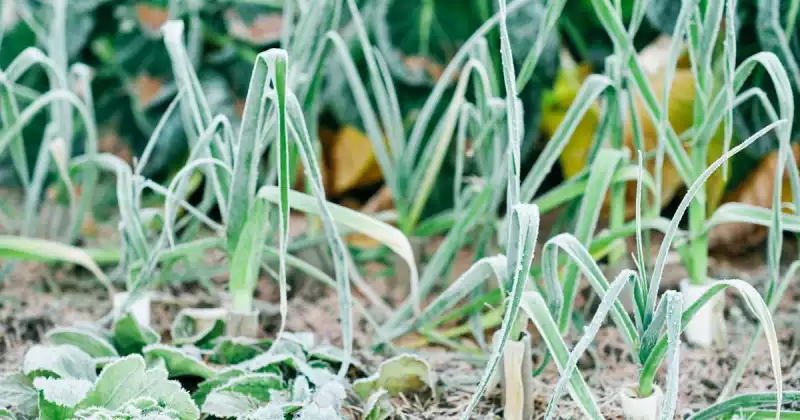
Early Winter Growing Season
The early winter growing season runs from October to December, depending on the location. The weather is typically mild during this period, with occasional frost and light snow. As a result, it is the perfect time to sow hardy vegetables such as kale, spinach, and collard greens, as well as root vegetables like carrots, beets, and turnips. 5
In colder regions, it is recommended to plant cold-tolerant vegetables such as garlic and onions in the early winter season to help establish their roots before the deep freeze sets in. Gardeners can also start indoor seeds or seedlings and transplant them outside later in the season, ensuring a more extended harvest period.
Mid-Winter Growing Season
The mid-winter growing season spans from January to February, the coldest period of the winter months. However, with proper techniques like cold frames, row covers, or hoop houses, gardeners can still grow hardy vegetables such as cabbage, broccoli, cauliflower, and Brussels sprouts.
And don’t neglect your inside cultivation! Mid-winter is also an excellent time to grow microgreens and sprouts indoors for added nutrition and freshness. Additionally, providing sufficient light and warmth through grow lights or heating pads can help boost plant growth and productivity.
Late Winter Growing Season
The late winter growing season lasts from March to April, signaling the end of the winter months and the beginning of spring. It is the perfect time to start seeds or seedlings for early spring planting and harvest. Gardeners can grow cold-tolerant vegetables such as radishes, spinach, and lettuce for a quick and easy harvest, along with peas, brassicas, and artichokes.
How To Harvest And Store Winter Vegetables
Harvesting and storing winter vegetables is crucial for ensuring they remain fresh and tasty for as long as possible. Below are the made-easy steps you’ll need on how to harvest and store winter vegetables:
- Specific Harvesting Techniques
- Cleaning And Storing Winter Vegetables
- Storage Location
- Storage Containers
- Proper Humidity And Ventilation
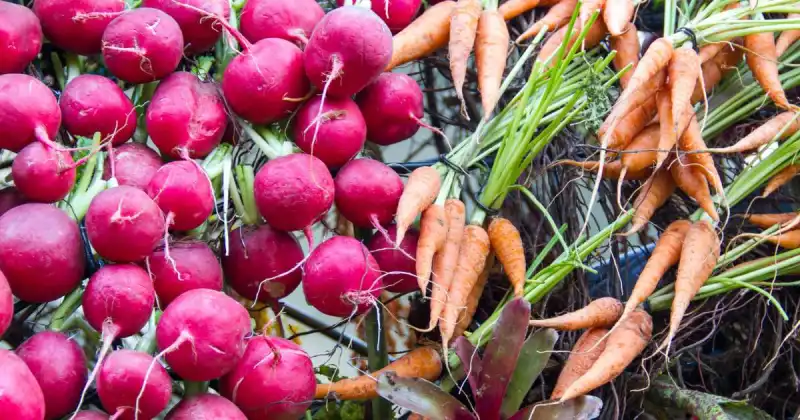
Harvesting Techniques
When harvesting winter vegetables, carefully cutting or pulling them is essential to avoid damage to the roots and stems. For example, for leafy greens such as kale, you can cut the outer leaves from the bottom of the plant first, leaving the center leaves to continue growing. For root vegetables like carrots, gently pull them from the soil by grasping the tops and tugging them gently.
It is also important to avoid bruising or damaging the vegetables during harvesting, as this can lead to spoilage during storage. Gardeners can use garden shears or a sharp knife to make clean cuts and avoid damaging the plants.
Cleaning And Storing Winter Vegetables
After harvesting, it is essential to clean the vegetables properly before storage. Dirt and debris can attract pests and cause unnecessary decay, so washing the vegetables thoroughly in cool water is recommended.
Once the vegetables are clean and dry, they should be stored in a cool, dark, and dry place such as a root cellar, refrigerator, or pantry. Some vegetables, such as cabbage, Brussels sprouts, and broccoli, can also be blanched and frozen for long-term storage.
Storage Location
As mentioned above, you’ll want to store winter vegetables in a cool, dry location such as a root cellar or refrigerator. Some vegetables, such as kale and Brussels sprouts, can even be left on the stem and hung in a cool location.
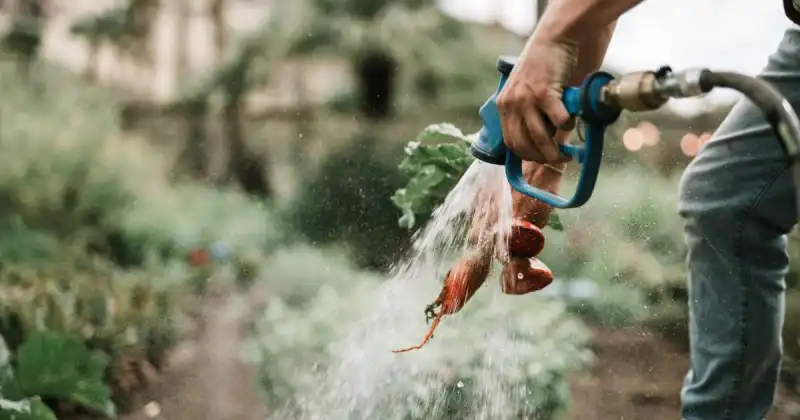
Storage Containers
Use appropriate storage containers for different types of vegetables. For example, root vegetables can be stored in boxes or bins filled with damp sand or sawdust to keep them moist. On the other hand, leafy greens can be stored in plastic bags or containers with a damp paper towel to prevent wilting for short-term storage.
Humidity And Ventilation
Proper humidity and ventilation are essential for storing winter vegetables. Depending on what you grow, some vegetables require high humidity, while others require low humidity. Ensure adequate ventilation to prevent the vegetables from rotting or molding prematurely.
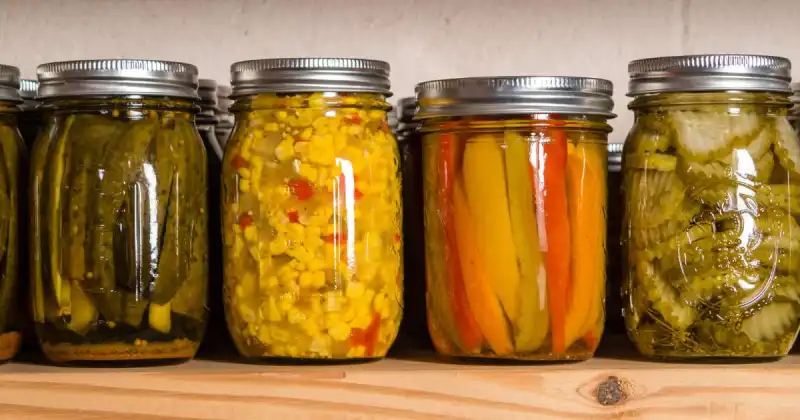
Tips For Keeping Vegetables Fresh For Longer
In keeping your winter vegetables fresh for as long as possible, it is recommended to follow these tips:
- Store each vegetable separately. Be sure to prevent cross-contamination between your veggies by separating each variety into individual containers, ensuring they remain fresh.
- Use airtight containers or plastic bags. By preventing excess oxygen from saturating your crops, you’ll help lessen the chances moisture spoils your harvested crops.
- Observe your stored produce. Check on the vegetables regularly and immediately remove any signs of spoilage to prevent them from contaminating others. 6
- Wash and thoroughly dry your vegetables BEFORE storing them. If you wash your veggies without drying, excess moisture may cause your homegrown grub to spoil faster, quickly turning your labor into compost filler.
Here’s a great video I found that explains all of the amazing winter vegetables you can grow, right in your own backyard, along with several tips on how to keep your plants healthy and productive!
Challenges Of Growing Winter Vegetables
There remain several common challenges in growing winter vegetables, including:
- Unpredictable weather patterns
- Unwelcome winter pests and diseases
- Limited daylight
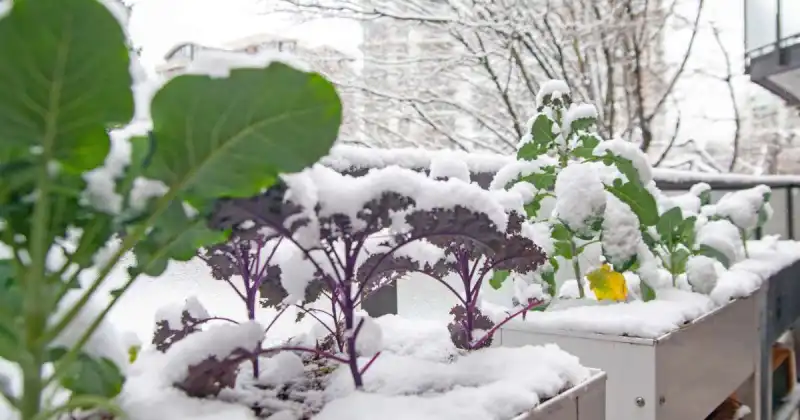
Weather Conditions
The colder temperatures and harsh weather conditions during winter can be challenging for plants and gardeners alike. Freezing temperatures can damage or kill tender vegetables, especially if your green friends haven’t been adequately hardened. Further, snow and ice can make even the most routine gardening tasks downright tricky. 7
To overcome these challenges, growers can use various techniques such as covering plants with row covers and frost blankets or using cold frames or hoop houses to protect the plants from the cold weather. Gardeners can also choose to plant hardy vegetables more resistant to colder temperatures.
Common Winter Vegetable Pests And Diseases
Interestingly, winter vegetable gardens can be just as susceptible to pests and diseases as during warmer periods, including aphids, cabbage worms, and powdery mildew. Therefore, it is important for gardeners to regularly inspect their plants for signs of damage or infestation, such as chewed leaves or wilted stems.
To prevent the spread of pests and diseases, growers can use crop rotation, companion planting, and proper plant spacing. In addition, organic pest and disease control methods promote plant health and reduce the need for harmful chemicals. However, these options may be slower and less effective in the colder months.
Limited Daylight Hours
Limited daylight during winter can significantly challenge any grower wanting a bountiful winter harvest. Most vegetables require a minimum of six hours (or more) of direct sunlight per day to grow and produce, but in some regions, winter daylight hours can be as low as three or four hours (at best) during the winter months. 8
Gardeners can provide artificial light using grow lights or reflectors to overcome this challenge. They can also choose to grow vegetables that require less sunlight, such as leafy greens, brassicas like broccoli and cabbage, and root vegetables that can tolerate some shade.
Benefits Of Growing Winter Vegetables
There are numerous benefits of extending your growing season well into winter, including:
- Nutritional Benefits
- Environmental Benefits
- Cost-Savings (something we all enjoy)

Nutritional Benefits
Eating winter vegetables has many benefits for both the body and the environment. Winter vegetables are rich in essential nutrients and can provide numerous health benefits, such as improving digestion and strengthening the immune system, even over the harsh winter.
For example, leafy greens such as spinach and kale are rich in vitamins A, C, and K, while root vegetables such as carrots and turnips are high in antioxidants and minerals. Another example is Swiss chard and kale, both known for their anti-inflammatory properties, while root vegetables such as beets and carrots are high in fiber, aiding digestion. 9
Additionally, growing homegrown winter vegetables can reduce your carbon footprint and minimize the use of harmful pesticides and fertilizers, which can negatively harm the environment and human health.
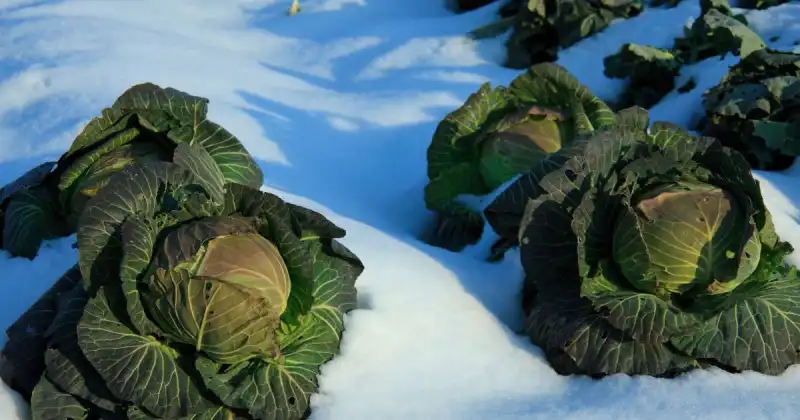
Environmental Benefits
Growing your winter vegetables has numerous environmental benefits. As previously mentioned, it reduces your carbon footprint by decreasing transportation, packaging, and refrigeration of produce, effectively lessening the demand on the supply chain pressures. Additionally, it reduces harmful pesticides and fertilizers, which may impact the environment and human health, successfully minimizing hazardous runoff into nearby lakes, streams, and land. 10
Cost-Saving
Growing your crops well into winter can significantly lower grocery bills, as you are not paying for transportation, packaging, or retail markup. Additionally, you can save significant money by preserving excess produce through canning, freezing, and proper storage techniques previously mentioned.
Moreover, growing winter vegetables reduces food waste, as you can harvest what you need and avoid throwing away spoiled or unused produce. Additionally, composting excess produce can help nourish the soil and support future harvests, making you more environmentally sustainable, and another excellent reason why I am a massive advocate of composting.
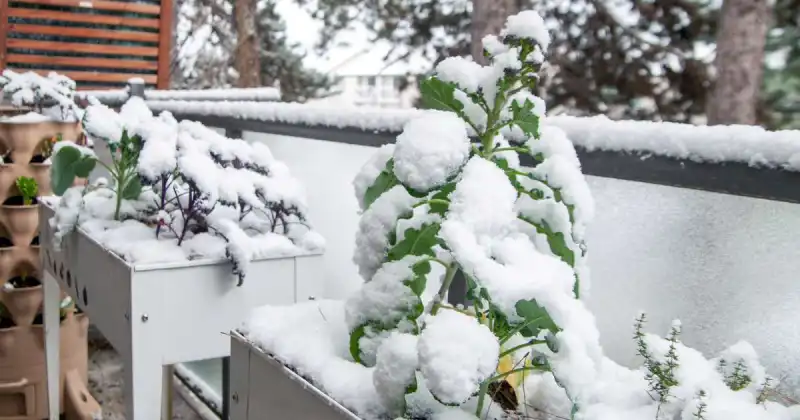
Conclusion
Winter vegetable gardening allows fresh produce to grow year-round, offering several environmental and health-conscious benefits. By understanding the three distinct winter growing seasons, using the right tools and techniques, and overcoming challenges, gardeners of all skill levels can create a successful and rewarding winter vegetable garden.
Plenty of delicious and nutrient-dense vegetables can be grown over winter, including kale, spinach, Swiss chard, carrots, beets, garlic, onions, winter squash, radishes, and brassicas like cabbage, Brussels sprouts, and cauliflower.
However, to grow these crops successfully, you must select the right location, prepare your soil accordingly, ensure your plants receive as much light as possible, and ensure your garden stays well-hydrated. If your region suffers from terribly cold winters, consider planting your vegetables in a greenhouse, hoop house, or cold frames to provide a warmer environment for your veggie friends.
Remember, just because it’s winter doesn’t mean you must stop growing. Surprisingly, plenty of gardeners ramp up their production as colder weather approaches to help provide delicious homegrown food for themselves and their families. So, don’t let the winter freeze you out from extending your season. All it takes is a little pre-planning, some robust plants, and a will to enjoy the nutritional benefits of nutritious winter veggies!
Do you currently grow over the winter in your region? Let us know which and what successful tips you can contribute to your fellow growers when Old Man Winter appears.
SOURCES
- University Of Maryland, Extension – Hardening Off Vegetable Seedlings For The Home Garden
- Food And Agriculture Organization Of The United Nations – Family Farming Knowledge Platform
- Denver Botanic Gardens – Winter Planning For Your Vegetable Garden
- ScienceDirect – Unheated Soil-Grown Winter Vegetables In Austria: Greenhouse Gas Emissions And Socio-Economic Factors Of Diffusion Potential
- Oregon State University, Extension Service – Growing Winter Vegetables
- National Library Of Medicine, National Center For Biotechnology Information – The Potential Of Five Winter-Grown Crops To Reduce Root-Knot Nematode Damage And Increase Yield Of Tomato
- Penn State University, Extension – Season Extenders And Growing Fall Vegetables
- University Of New Hampshire – Extending The Season And Overwintering Garden Veggies, Winter Sowing, Lovage, And Putting The Garden To Bed [Audio]
- New Mexico State University, College Of Agricultural, Consumer, And Environmental Sciences – Hoop House Vegetable Production
- National Weather Service – Frost And Freeze Information


